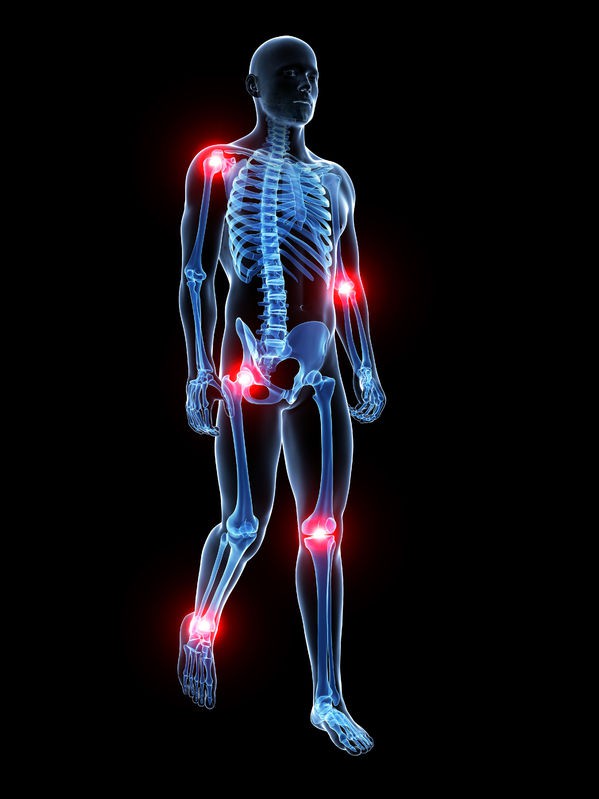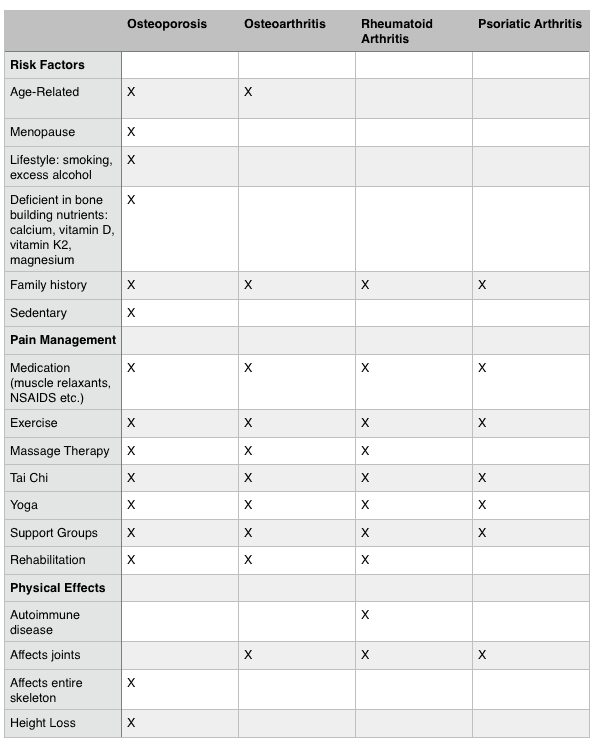Is Osteoporosis Painful?
Osteoporosis itself does not hurt.
Without a DEXA scan – or the trauma of a fracture – you won’t even know you have it.
But the damage it causes can hurt.
Osteoporosis develops silently. There is no feeling of “gradual bone density loss.” There are no warning signs of an imminent fracture. And some estimates report one and one-half million – 1,500,000 – Americans will suffer a fracture due to osteoporosis in the next 12 months.
Common Osteoporosis Pain Areas

The “silence” usually ends with a simple fall – one that would normally leave a small bruise – or even from the stress of lifting a little too much weight (like a heavy suitcase or grocery bad.)
The source of pain with osteoporosis could be one of the following:
- A Microtrabecular Fracture. These are tiny little cracks in your bones. They often occur in the spine, and may result in a loss of height. (Good tip here; when you check your weight every month, check your height too.) But often, people with this first sign of osteoporosis call the pain, “an achy back.”
- A Compression Fracture. The discs between your spine bones act as cushions. But osteoporosis causes your vertebra to collapse these discs. Every year, about 750,000 of these compression fractures happen in the US. Untreated, these fractures can lead to the “dowager’s hump” – the permanent arching of the back. Then, you face increased pain, loss of mobility and damage to muscles and ligaments in your back.
- Rib Pain. The spinal fracture can pinch a nerve causing rib pain. Or, there can be small fractures in the rib itself, sometimes from as simple a cause as a vigorous sneeze!
- A Stress Fracture. Brittle bones doe not perform well under the stress of a simple fall or strenuous exercise. Often, these stress fractures happen in the hip, and they can be deadly! 20% of people with a hip fracture die within one year.
Osteoporosis Pain Management
So, How do You Manage Osteoporosis Pain?
First, while osteoporosis is a “silent killer” you do NOT have to be a silent victim.
There are many ways you can manage, control and reduce the pain. Here are a few…
- R & R – Rest and Rehabilitation. Work with a physical therapist to design a plan to rehab your pain area, a plan that includes plenty of rest.
- Pain Meds. Over-the-counter (OTC) pain drugs can help ease acute pain, but ALL pain drugs have side effects. Consult with your doctor or pharmacist to find a helpful pill.
- Hot and Cold. Apply hot packs and ice bags (alternate between the two for no more than 15 minutes each) to help reduce pain in the area of a fracture.
- Brace. For some people, a back brace can relieve the pain. Usually though, this is simply assisting with muscle or ligament pain and does little to help the main pain cause, osteoporosis.
- Lifestyle Changes. You can reduce osteoporosis pain when you learn new ways to move. Find a new way to bend, lift and twist. This is especially important if you are suffering from osteoporosis back pain. Even changing how you walk up and down stairs can ease some pain.
- Support Bone Health. It really is a simple formula: bone density loss causes the fractures, and the fractures cause the pain. So, why not start with rebuilding your bones? That’s why we recommend AlgaeCal Plus and Strontium Boost to build – and rebuild – bone density. Working in combination, these two supplements add much needed plant-based calcium to your system, increases the two vitamins (D3 and K2) critical to getting that calcium into your bones (and not into your heart or arteries.) Plus, AlgaeCal Plus contains ALL of the other 12 known essential bone supporting minerals (alongside calcium) vital to rebuilding bone density. And Strontium Boost gets maximum strontium – a critical part of your bones – right to work for your health.
The best answer is to stop the pain BEFORE it starts.
That’s why you can count on AlgaeCal Plus and Strontium Boost to give you all the essential bone building materials you need. And they are guaranteed to build your bone mineral density within 180 days, or you get your money back!
Image that – stop the pain before it starts, or reduce the pain after it starts – with no risk at all! You can finds out more about both AlgaeCal Plus and Strontium Boost when you click here.
Osteoporosis Pain FAQ’s
What is Osteoporosis?
Osteoporosis is a disease of the bones and means “porous bone.”
It happens when you lose too much bone, make too little bone or both. Your bones become weak and may break from a minor fall or, in serious cases, even from simple actions, like sneezing or bumping into furniture.
When you examine healthy bone under a microscope, you see that parts of it look like a honeycomb. With osteoporosis, the holes and spaces in the honeycomb are much bigger than in healthy bone. Your bones lost density or mass. The makeup of your bone tissue is abnormal. As your bones become less dense, they also become weaker and more likely to break.
What is the difference between osteoarthritis and arthritis?
Arthritis is a general medical term for any chronic condition that causes damage to the cartilage and joints.
With osteoarthritis, joint damage is caused by natural wear and tear over time. With rheumatoid arthritis, the body’s own immune system attacks the joints, leading to swelling, pain and the eventual destruction of cartilage at the joint. Unlike “wear and tear” osteoarthritis, rheumatoid arthritis affects the interior lining of the joints.
Osteoarthritis is one of the most common forms of arthritis. This condition occurs when the protective cartilage covering the ends of the bones wears down over time. While treatments can slow the progression of this chronic condition and relieve pain, there is no cure.
What are the different types of arthritis?
There are more than 100 different forms of arthritis and related diseases. The 3 most common types include osteoarthritis (OA), rheumatoid arthritis (RA), and psoriatic arthritis (PsA). All of them can cause pain in different ways.
Osteoarthritis
Joints that bear weight — such as your knees, hips, feet, and spine — are the most common places you find osteoarthritis. It often appears gradually over months or years. It makes the affected joint hurt. But you don’t feel sick or have the fatigue that comes with some other types of arthritis. More people suffer from this condition than any other form of arthritis. It’s the “wear and tear” that comes from overuse of your joints. Age is a major contributor, but it can also come from joint injuries or obesity, which puts extra stress on your joints.
Rheumatoid Arthritis
RA is an autoimmune disease. That means your own immune system attacks parts of your body, especially your joints. That creates inflammation and severe joint damage if you don’t treat it. About 20% of people who have rheumatoid arthritis get rheumatoid nodules – lumps on their skin. These often form over pressure-joints such as your knuckles, elbows, or heels.
Psoriatic Arthritis
With Psoriatic Arthritis, you get psoriasis – inflammation of the skin – and arthritis – inflammation of the joints.
Psoriasis causes patchy, raised, red, and white areas of inflamed skin with scales. It usually affects the tips of the elbows and knees, the scalp, the navel, and skin around the genital areas or anus.
Only about 10% to 30% of people with psoriasis will also get psoriatic arthritis.
And what are the similarities and differences among osteoporosis, osteoarthritis, rheumatoid arthritis, and psoriatic arthritis?
Read the chart below:

Is osteoporosis painful?
As discussed above, osteoporosis itself does not hurt. But this leads us to the next question…
Can bones hurt?
Yes.
Bone pain is extreme tenderness, aching, or other discomfort in one or more bones. Bone pain differs from muscle and joint pain because your feel bone pain regardless if you move around or just sit or lay down. There are many potential illnesses, conditions and diseases that can cause bone pain.
- Injury: Injury is a common cause of bone pain. Typically, this pain arises when a person experiences some form of trauma, like a car accident or a fall. The impact may break or fracture the bone.
- Cancers. Bone cancer, leukemia, and metastatic cancer (a cancer that started somewhere else in the body but spreads to the bones), cancer of the breast, lung, thyroid, kidney, and prostate are among the cancers that commonly spread to bone.
- Disturbed blood supply to your bones: Some diseases interfere with the blood supply to the bone. Your bones need a steady supply of blood; without it the tissue of the bone dies. This causes significant bone pain and weakens the bone. Sickle cell disease is an example of a condition that disrupts blood supply.
- Infection: An infection that starts in, or spreads to, the bones, can cause a serious condition called osteomyelitis. An infection of the bone can kill bone cells and cause bone pain.





Goretti Ferreira
May 7, 2016 , 3:08 pmDo you sell L vitamin? I would like to have.